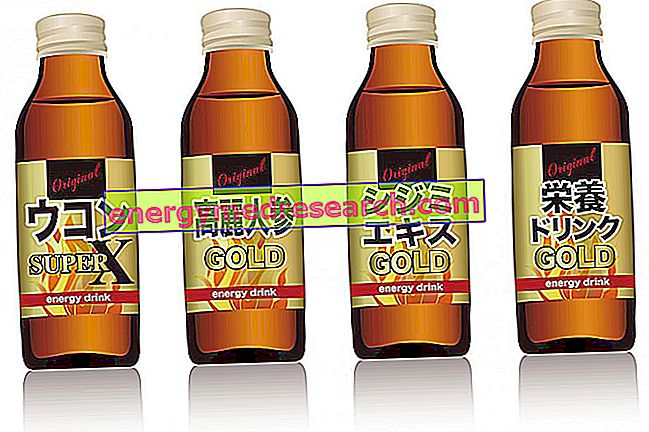HEALTH PASSES FOR THE FIVE COLORS OF FRUIT AND VEGETABLES!
Color Diet
Mediterranean diet: rich in colors and natural foods
For years, nutritionists have been enhancing the "Mediterranean diet" because it is based on the intake of natural, healthy and poorly processed foods.

Why are fruits and vegetables good for your health?
We all know that eating lots of fruit and vegetables is good for your health, but we asked ourselves why?
The health properties are due to the content of water, vitamins, mineral salts, sugars, fibers and compounds called phytoalexins (in English phytochemicals ). These substances give vegetables and fruit their own color and are important both for the plants themselves and for the human organism:
- For plants, thanks to the protective action against microorganisms and parasites.
- For the human organism thanks to the protective action against equipment and systems.
Each fruit and vegetable has a certain characteristic composition and for this reason it is advisable to eat as many varieties as possible.
In this way the body can absorb the right mix of essential substances to satisfy all its needs.
Importance of colors in the diet of fruit and vegetables
We therefore need to eat different types of fruit and vegetables every day, in order to ingest the correct amount of fiber and phytochemicals.
Here then that the colors take over in the diet!
In fact, recent studies have shown that it is good to consume, every day, five fruit and vegetable products with different colors: white, green, red, yellow / orange, purple / blue.
A portion is equivalent to:
- A side dish of raw or cooked vegetables (50-250 g)
- A medium-sized fruit (100-200 g), to be used as a snack, at the end of a meal or at breakfast
- A centrifuged fruit and / or vegetable (150-250 ml), to be consumed as a drink.
By managing to adopt these habits and maintaining an active (non-sedentary) lifestyle, it has been shown that the risk of tumors is reduced by 1/3 and a certain general physical well-being is maintained.
Following these tips is important at all stages of life, so it is recommended from the first years of age.
Let us now see, as a component component, the beneficial properties of fruit and vegetable products.
Properties of the Color Diet
What are the beneficial nutritional characteristics of the color diet?
The chemical properties of the color diet, which outline a beneficial and almost therapeutic effect, are:
- Richness of phytochemicals or phytoalexins
- Richness of vitamins
- Beneficial mineral wealth and low sodium intake
- Fiber richness
- Water wealth
Let's analyze them one at a time.
Phytochemicals wealth
Importance of phytochemicals or phytoalexins
Phytochemicals or phytoalexins give the fruit and vegetables their characteristic color.
Polyphenols, anthocyanins, carotenoids and chlorophylls are the main phytochemicals of fruit and vegetables, and have the function of protecting the body by reducing the risk of:
- Oxidative stress
- tumors
- Total hypercholesterolemia and LDL
- Primary arterial hypertension
- Type 2 diabetes mellitus
- Atherosclerosis
- Thrombosis
- Cardio-cerebro-vascular events.
Vitamin wealth
Fruit and vegetable vitamins: what are they and what are they for?
Vitamins are small but complex molecules, important for all cellular and consequently body functions.
For example, vitamin A ensures good vision, vitamin C supports the immune system and is the basis of collagen production; vitamin D guarantees the formation of bone tissue; certain B-complex vitamins act as enzymes and coenzymes for energy metabolism (they help process carbohydrates, proteins, fats) and are necessary for cell differentiation; vitamin E protects essential fats from free radials; Vitamin K has the so-called anti-hemorrhagic function etc.
Certain vitamins have significant antioxidant power and, in addition to slowing down aging, protect (like phytoalexins) from the onset of tumors and metabolic disorders.
Fruit and vegetables are mainly rich in:
- Antioxidant vitamins:
- Carotenoids (pro vitamins A such as beta carotene and lycopene): mainly contained in orange fruits and vegetables (peppers, chilli, tomato, carrots, strawberries, cherries, melon, peaches, apricots, etc.)
- Ascorbic acid (vitamin C): contained above all in the sour fruit (lemon, orange, grapefruit, strawberries, cherries, apples, etc.) and in certain vegetables (cauliflower, parsley, chilli, lettuce, radicchio, etc.)
- Tocopherols (vitamin E), especially alpha tocopherol: it is present a little everywhere even if in small quantities. The avocado, olives, spinach, turnip greens and above all the oil seeds or extracted oils are very rich.
- Vitamin K: actually, it is not that abundant, but vegetables are still the main food source.
- Folate: necessary for the synthesis of nucleic acids (very important for the development of the fetus), they abound in vegetables rich in chlorophyll (such as spinach, lettuce, radicchio, chicory, etc.) and in some fruits (such as apples and oranges) .
Minerals Good
Both potassium, magnesium and little sodium
The diet of fruit and vegetables is particularly suitable for those who suffer from metabolic and / or cardiovascular diseases.
This is because fruits and vegetables are rich in potassium, magnesium and at the same time contain little sodium (the excess of which is implicated in the etiology of high sodium sensitive pressure).
Potassium promotes urinary sodium excretion and together with magnesium helps maintain an alkaline PRAL.
Fiber wealth
The diet of fruit and vegetables increases fiber
Fruits and vegetables contain a high percentage of fiber, most of which is soluble-viscous.
Fiber functions:
- They fight constipation and promote the regularity of the alvus
- They are not digested by the body, but favor the elimination of harmful substances
- They modulate nutritional absorption, helping to lower the level of cholesterol in the blood and decreasing the glycemic index
- They provide a high sense of satiety, limiting food consumption; useful aspect in slimming diets
- They exert a prebiotic effect and maintain the trophism of the intestinal bacterial flora.
Water wealth
70% of our body is made up of water which, not only for this reason, is considered an essential nutrient. Water is in fact the matrix in which all the processes that allow the cells to reproduce and conserve take place.
It is also for this reason that doctors and nutritionists recommend drinking at least a liter of water a day. This indication does not correspond to our actual requirement, which is at least double (about 2 liters for an average adult). Therefore, in addition to the liter of drinking water, the remaining 50% of the water requirement is covered by food and above all by: fruit, vegetables and milk; secondly (but not too much) come cooked meat, fish and cereals.
This is why sportsmen, who have a greater need for water to compensate for sweating, are generally advised against eating preserved foods (cheeses, seasoned meats, etc.).
Water is also essential, in the right quantities (one or two glasses per meal, depending on the composition), to ensure proper digestion.
Seasonality of Fruit and Vegetables
Importance of seasonality for fruit and vegetables
Respecting the seasonality of fruit and vegetables is necessary to be certain of their nutritional richness. In fact, the products long stored in cold storage (greater exposure to oxidative stress), or obtained from intensive agriculture, have a lower chemical value than normal.
Hence the recommendation to prefer seasonal fruits and vegetables, preferably local or "short chain".
Even the poorly preserved seasonal fruit is exposed to free radicals, oxygen and light, losing most of the nutrients sensitive to them.
Raw and cooked fruits and vegetables?
Is it better to prefer raw or cooked fruit and vegetables?
Both must be present in the diet, but the nutritional richness of thermolabile molecules is guaranteed especially in raw products.
Among the thermolabile molecules, above all, certain vitamins stand out, which are notoriously degraded by heat (especially C and folates).
Furthermore, cooking the fruit and vegetables by drowning (or boiling) takes place a dilution of the minerals in the surrounding liquid.
Cooked fruits and vegetables are useful to increase the portions and therefore the contribution of fibers which, among other things, become even more soluble - viscous. In this way they are more useful in modulating the intestine and as prebiotics.
Article Index
RossoGiallo-ArancioVerdeViola-bluBiancoVideoricette
Recipe to prepare light filled vegetables, with little oil but very very tasty. Follow our video recipe



